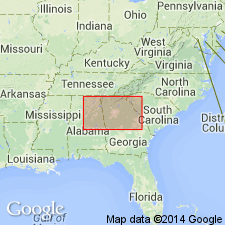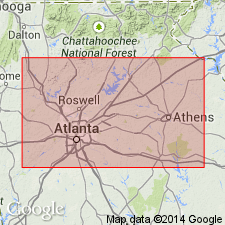
- Usage in publication:
-
- Red Top Mountain Schist*
- Modifications:
-
- Named
- Dominant lithology:
-
- Schist
- AAPG geologic province:
-
- Piedmont-Blue Ridge province
Summary:
The Red Top Mountain Schist of the Allatoona Complex is here named for exposures in Red Top Mountain State Park, GA. It consists of highly deformed and generally granitized red, silver, and gray schists that occur as xenoliths and roof-pendants in Corbin Gneiss, and which also form its country rock. Age is Middle Proterozoic.
Source: GNU records (USGS DDS-6; Reston GNULEX).

- Usage in publication:
-
- Red Top Mountain Formation*
- Modifications:
-
- Revised
- Age modified
- AAPG geologic province:
-
- Piedmont-Blue Ridge province
Summary:
Detailed mapping has shown that rocks assigned to Red Top Mountain Schist by Higgins and others (1988) are not schist except where sheared. Most prevalent rock is high-grade metamorphosed mafic meta-igneous rock intruded by Corbin Metagranite (revised) and exposed as xenoliths and roof pendants. Name is therefore changed to Red Top Mountain Formation. Red Top Mountain Formation intrudes Early(?) to Middle Proterozoic Rowland Spring Formation (new). Age is changed to Early(?) to Late(?) Proterozoic because it must be older than Middle(?) to Late Corbin Metagranite which has intruded it.
Source: GNU records (USGS DDS-6; Reston GNULEX).
For more information, please contact Nancy Stamm, Geologic Names Committee Secretary.
Asterisk (*) indicates published by U.S. Geological Survey authors.
"No current usage" (†) implies that a name has been abandoned or has fallen into disuse. Former usage and, if known, replacement name given in parentheses ( ).
Slash (/) indicates name conflicts with nomenclatural guidelines (CSN, 1933; ACSN, 1961, 1970; NACSN, 1983, 2005, 2021). May be explained within brackets ([ ]).

